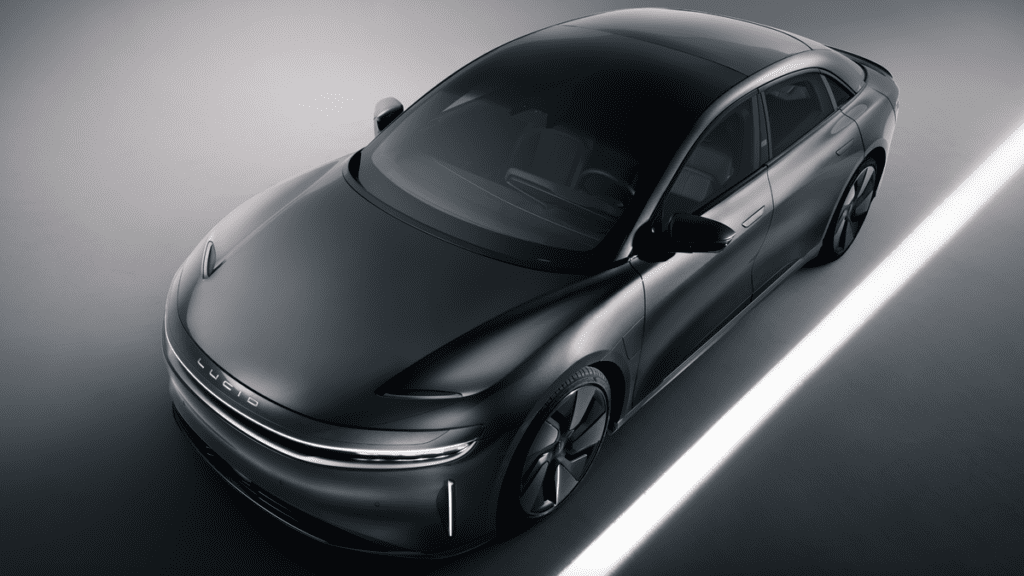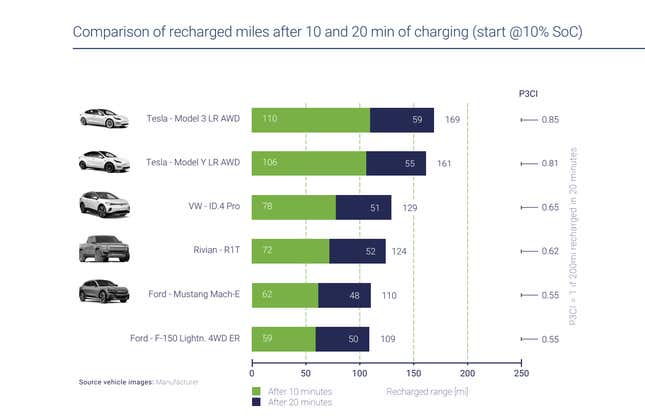The Lucid Air Is Fastest For 20-Minute Charging: Report

The P3 Group is a German consulting firm that employs people that, like most consulting firms, seem to have too much time on their hands, in this case enough time to create a report that measures charge times in the U.S. for popular EV models after just 20 minutes, or more than the average American spends at a gas station for a fill up but less than the amount that Americans imagine EVs need for a significant recharge. Lucid’s Air Grand Touring, which was able to get up 208 miles of range after 20 minutes, was the model on top.
Tesla’s Big Discounts Worked, Sort Of
Automotive News summarizes:
The six-figure Lucid Air Grand Touring might be their best bet. It achieves the most range during a 20-minute charging session, according to a new report from consulting firm P3 Group. It got 208 miles in 20 minutes, the top charging metric among the 13 EVs analyzed in the report.
With a price tag of $139,650 including destination fees, customers are getting what they pay for. Tesla’s Model S Plaid ranked second in the study, and the Kia EV6 LR RWD finished third. The EV6 charged 191 miles — only 17 miles from the top spot — in 20 minutes. At $43,920, it costs nearly $100,000 less.
[…]
Tesla dominated the rest of the top five, with its Model 3 LR AWD at No. 4 and the Model Y LR AWD at No. 5.
Prices for the Tesla models spanned from $48,630 to $109,880 with ranges of 330 to 396 miles. The overall range of the Lucid Air GT is an EPA-estimated 516 miles and the EV6 is estimated at 310 miles on a full charge.
Much of Tesla’s success in the report is attributed to its Supercharger network, superior to the other charging options in America, as Electrify America’s charging network is less good. On the bottom end, the Ford F-150 Lightning charged to just 109 miles of range in 20 minutes, according to P3 Group, the Mustang Mach-E got 110 miles, and the Rivian R1T got 124 miles.
Screenshot: P3 Group

Screenshot: P3 Group
The EV trucks there aren’t so surprising, given that their aerodynamics are bad and the Lucid Air’s are quite good, as are Teslas’. P3 Group also said that battery architecture was a factor.
The Lucid Air GT ranks highest with a P3CI – US of 1.04 and is the only vehicle with an index greater than 1.0. Its top rank can be attributed to high charging power and low consumption. The Tesla Model S Plaid achieves an index of 0.97 and the KIA – EV6 LR RWD of 0.96 in the first P3 Charging Index – US, placing them 2nd and 3rd. Although two of the leading three cars are luxury cars, the KIA proves that non-luxury cars are capable of long ranges. Four of the top five cars are US models.
Comparing the P3CI – US rating to the vehicle data of the electric vehicles demonstrates that the long-distance suitability of electric vehicles depends on multiple factors. One of those is the 800 V architecture which enables higher charging power, although this only positively impacts long-distance suitability in combination with low consumption. The Porsche Taycan GTS featured an 800 V architecture and was able to maintain outstanding charging power until close to 46% SoC; however, because of its high consumption, only ranks 6th overall. Despite their lower 400 V architecture and average charging power, all three Tesla models rank higher due to their low consumption. The determining factors for the low ranking of the bottom five cars are attributed to low average charging power (VW ID.4 Pro, Ford Mustang Mach-E, and Polestar 2 LR Single Motor) or high consumption (Rivian R1T and Ford F-150 Lightning).
None of this, then, tells you anything that you can’t already sense intuitively, though, it does also add some color to GM and Ford’s decisions to go Supercharger. Lucid, meanwhile, is caught in a familiar place, with a product that gets high marks but with not the right attention, in this case a report from a consulting firm called P3 Group.


